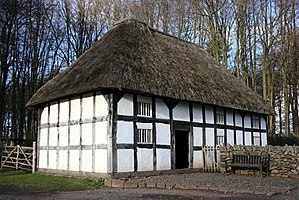Wattle and daub


Wattle and daub is a composite building material. This ancient building method is commonly used in vernacular architecture throughout the world, and was used throughout Britain at least as far back as neolithic settlers.
Wattle is in reference to wooden or wicker lath that is woven between sticks to create a lightweight wall. This is then smeared with daub—a material made from clay, animal dung, hair, straw, and other fibrous particulate that aids as a structural binding agent.
Preservation
Many structures have been damaged through replacing the breathable daub with concrete or the like, as it does not allow moisture to escape. Moisture then collects at the wooden beams rotting them. The breathable nature of thatch, daub, plaster and other natural materials means that well-maintained buildings have been known to last 500 years or more.